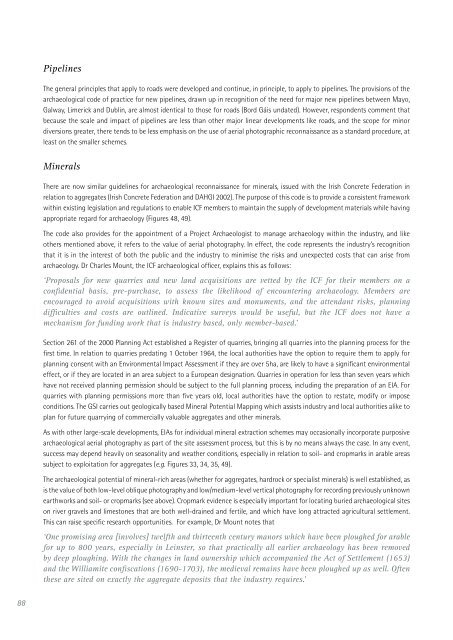Aerial Archaeology in Ireland - The Heritage Council
Aerial Archaeology in Ireland - The Heritage Council
Aerial Archaeology in Ireland - The Heritage Council
You also want an ePaper? Increase the reach of your titles
YUMPU automatically turns print PDFs into web optimized ePapers that Google loves.
88<br />
Pipel<strong>in</strong>es<br />
<strong>The</strong> general pr<strong>in</strong>ciples that apply to roads were developed and cont<strong>in</strong>ue, <strong>in</strong> pr<strong>in</strong>ciple, to apply to pipel<strong>in</strong>es. <strong>The</strong> provisions of the<br />
archaeological code of practice for new pipel<strong>in</strong>es, drawn up <strong>in</strong> recognition of the need for major new pipel<strong>in</strong>es between Mayo,<br />
Galway, Limerick and Dubl<strong>in</strong>, are almost identical to those for roads (Bord Gáis undated). However, respondents comment that<br />
because the scale and impact of pipel<strong>in</strong>es are less than other major l<strong>in</strong>ear developments like roads, and the scope for m<strong>in</strong>or<br />
diversions greater, there tends to be less emphasis on the use of aerial photographic reconnaissance as a standard procedure, at<br />
least on the smaller schemes.<br />
M<strong>in</strong>erals<br />
<strong>The</strong>re are now similar guidel<strong>in</strong>es for archaeological reconnaissance for m<strong>in</strong>erals, issued with the Irish Concrete Federation <strong>in</strong><br />
relation to aggregates (Irish Concrete Federation and DAHGI 2002). <strong>The</strong> purpose of this code is to provide a consistent framework<br />
with<strong>in</strong> exist<strong>in</strong>g legislation and regulations to enable ICF members to ma<strong>in</strong>ta<strong>in</strong> the supply of development materials while hav<strong>in</strong>g<br />
appropriate regard for archaeology (Figures 48, 49).<br />
<strong>The</strong> code also provides for the appo<strong>in</strong>tment of a Project Archaeologist to manage archaeology with<strong>in</strong> the <strong>in</strong>dustry, and like<br />
others mentioned above, it refers to the value of aerial photography. In effect, the code represents the <strong>in</strong>dustry’s recognition<br />
that it is <strong>in</strong> the <strong>in</strong>terest of both the public and the <strong>in</strong>dustry to m<strong>in</strong>imise the risks and unexpected costs that can arise from<br />
archaeology. Dr Charles Mount, the ICF archaeological officer, expla<strong>in</strong>s this as follows:<br />
‘Proposals for new quarries and new land acquisitions are vetted by the ICF for their members on a<br />
confidential basis, pre-purchase, to assess the likelihood of encounter<strong>in</strong>g archaeology. Members are<br />
encouraged to avoid acquisitions with known sites and monuments, and the attendant risks, plann<strong>in</strong>g<br />
difficulties and costs are outl<strong>in</strong>ed. Indicative surveys would be useful, but the ICF does not have a<br />
mechanism for fund<strong>in</strong>g work that is <strong>in</strong>dustry based, only member-based.’<br />
Section 261 of the 2000 Plann<strong>in</strong>g Act established a Register of quarries, br<strong>in</strong>g<strong>in</strong>g all quarries <strong>in</strong>to the plann<strong>in</strong>g process for the<br />
first time. In relation to quarries predat<strong>in</strong>g 1 October 1964, the local authorities have the option to require them to apply for<br />
plann<strong>in</strong>g consent with an Environmental Impact Assessment if they are over 5ha, are likely to have a significant environmental<br />
effect, or if they are located <strong>in</strong> an area subject to a European designation. Quarries <strong>in</strong> operation for less than seven years which<br />
have not received plann<strong>in</strong>g permission should be subject to the full plann<strong>in</strong>g process, <strong>in</strong>clud<strong>in</strong>g the preparation of an EIA. For<br />
quarries with plann<strong>in</strong>g permissions more than five years old, local authorities have the option to restate, modify or impose<br />
conditions. <strong>The</strong> GSI carries out geologically based M<strong>in</strong>eral Potential Mapp<strong>in</strong>g which assists <strong>in</strong>dustry and local authorities alike to<br />
plan for future quarry<strong>in</strong>g of commercially valuable aggregates and other m<strong>in</strong>erals.<br />
As with other large-scale developments, EIAs for <strong>in</strong>dividual m<strong>in</strong>eral extraction schemes may occasionally <strong>in</strong>corporate purposive<br />
archaeological aerial photography as part of the site assessment process, but this is by no means always the case. In any event,<br />
success may depend heavily on seasonality and weather conditions, especially <strong>in</strong> relation to soil- and cropmarks <strong>in</strong> arable areas<br />
subject to exploitation for aggregates (e.g. Figures 33, 34, 35, 49).<br />
<strong>The</strong> archaeological potential of m<strong>in</strong>eral-rich areas (whether for aggregates, hardrock or specialist m<strong>in</strong>erals) is well established, as<br />
is the value of both low-level oblique photography and low/medium-level vertical photography for record<strong>in</strong>g previously unknown<br />
earthworks and soil- or cropmarks (see above). Cropmark evidence is especially important for locat<strong>in</strong>g buried archaeological sites<br />
on river gravels and limestones that are both well-dra<strong>in</strong>ed and fertile, and which have long attracted agricultural settlement.<br />
This can raise specific research opportunities. For example, Dr Mount notes that<br />
‘One promis<strong>in</strong>g area [<strong>in</strong>volves] twelfth and thirteenth century manors which have been ploughed for arable<br />
for up to 800 years, especially <strong>in</strong> Le<strong>in</strong>ster, so that practically all earlier archaeology has been removed<br />
by deep plough<strong>in</strong>g. With the changes <strong>in</strong> land ownership which accompanied the Act of Settlement (1653)<br />
and the Williamite confiscations (1690-1703), the medieval rema<strong>in</strong>s have been ploughed up as well. Often<br />
these are sited on exactly the aggregate deposits that the <strong>in</strong>dustry requires.’

















